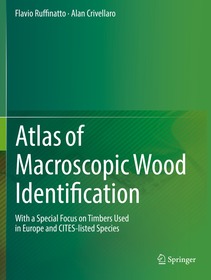
Atlas of Macroscopic Wood Identification
With a Special Focus on Timbers Used in Europe and CITES-listed Species
- Publisher's listprice EUR 234.33
-
97 188 Ft (92 560 Ft + 5% VAT)
The price is estimated because at the time of ordering we do not know what conversion rates will apply to HUF / product currency when the book arrives. In case HUF is weaker, the price increases slightly, in case HUF is stronger, the price goes lower slightly.
- Discount 12% (cc. 11 663 Ft off)
- Discounted price 85 525 Ft (81 453 Ft + 5% VAT)
Subcribe now and take benefit of a favourable price.
Subscribe
97 188 Ft

Availability
printed on demand
Why don't you give exact delivery time?
Delivery time is estimated on our previous experiences. We give estimations only, because we order from outside Hungary, and the delivery time mainly depends on how quickly the publisher supplies the book. Faster or slower deliveries both happen, but we do our best to supply as quickly as possible.
Product details:
- Edition number 1st ed. 2019
- Publisher Springer International Publishing
- Date of Publication 17 December 2020
- Number of Volumes 1 pieces, Book
- ISBN 9783030235680
- Binding Paperback
- See also 9783030235659
- No. of pages439 pages
- Size 279x210 mm
- Weight 1241 g
- Language English
- Illustrations X, 439 p. 375 illus. in color. Illustrations, color 151
Categories
Long description:
This atlas presents macroscopic descriptions, macro cross section pictures, general characteristics and identification keys of 335 wood species currently introduced in the European timber market from all over the world. Overall 292 different genera are represented and CITES-listed timbers are also included. Macroscopic descriptions are based on a recently proposed list of macroscopic features for wood identification. Macroscopic features and their codes are defined and illustrated in the atlas. Wood descriptions also include information about natural durability, physical and mechanical properties, end uses, environmental sustainability and possible related misleading commercial names. Furthermore, each genus is described in terms of number of species, geographical distribution and main commercial timbers, and details are given about to what extent timbers within the genus can be typically identified through macroscopic and microscopic analysis, if any.
The atlas will be a valuable guide for all agents in charge for timber verification, those involved in the European Timber Regulation enforcement and CITES inspections, as well as wood scientists, foresters, wood sellers, wood restorers, and any wood worker and wood passionate interested in a fast and reliable tool for wood identification.
MoreTable of Contents:
Introduction.- Background of the study, aims and scope.- Wood structure and plans of observations.- Brief introduction on wood structure and plans of observation for macroscopic identification.- Samples preparation and observation.- Instructions on how to prepare samples and observe them.- Materials and methods.- Origin of the material studied, samples preparation and photos acquisition.- Definition of Macroscopic Features.- List of macroscopic features with definitions and illustrations.- Identification key.- Wood descriptions.- References.- Index of species.
More



